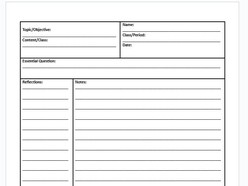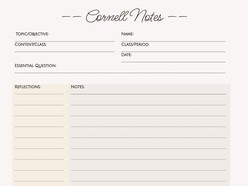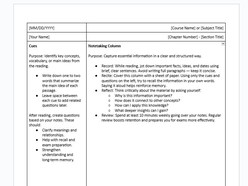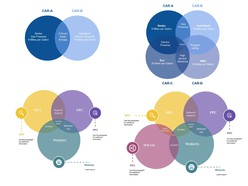The Full-Page Cornell Notes Google Docs Template offers a highly efficient and structured layout for effective note-taking. Designed with a minimalist, space-maximizing format, this template is optimized for clarity, organization, and printability.
Key Features:
- Full-page layout for extensive note-taking without wasted space.
- Minimalist design ensuring clear readability and focus.
- Optimized for printing with a clean, ink-friendly format.
- Classic Cornell structure with distinct Cue, Notes, and Summary sections.
- Flexible and editable in Google Docs for customization.
Ideal for students, researchers, and professionals, this template helps streamline study sessions, enhance retention, and organize key concepts efficiently.
Format: Google Docs
Contributed by: Alex Janovich
How to Download and Use the Template
Getting started with Google Docs templates is quick and simple:
- Click the Download Template button.
- When the template opens, click the Use Template button at the top of the page.
- Make sure you're signed into your Google account, as it's required to save and edit the template.
10 Best Tips for Creating Cornell Notes
Divide Your Page: Start by drawing a vertical line about 2.5 inches from the left edge of your paper, and a horizontal line about 2 inches from the bottom. This creates the main sections: a narrow left column, a wider right column, and a space at the bottom.
Use the Left Column for Cues: The left column is where you jot down cues or keywords about the content in the right column. These cues will help you recall the main ideas during review.
Right Column for Main Notes: Take your main notes in the right column. Summarize the content, avoid lengthy sentences, and focus on key points, definitions, and explanations.
Abbreviate and Use Symbols: To save time and space, use abbreviations and symbols when taking notes. Develop a set of personal shorthand that you can easily understand.
Highlight or Underline: During or after the lecture, use a highlighter or underline important information. This will help key points stand out when you review your notes.
Questions in the Bottom Section: In the bottom section of your page, write questions, thoughts, or cues related to the notes you've taken. This will help you engage with the material and prepare for discussions or assignments.
Summarize: At the end of the lecture or reading, take a few moments to summarize the key points in the main notes section. This concise summary will be valuable for quick review.
Review and Self-Quiz: When you study, cover the right column (main notes) and use the cues and questions in the left and bottom sections to self-quiz. This active recall technique is an effective way to reinforce your memory.
Create a Title: Give each set of Cornell notes a title, including the date and source (lecture, textbook chapter, etc.). This makes it easier to locate and organize your notes later.
Personalize Your System: Cornell notes are a flexible system. Feel free to adapt and personalize it to your liking. Some people like to use different colors for highlighting, while others use digital tools for creating digital Cornell notes.
Remember that the key to effective note-taking with the Cornell method is active engagement with the material and regular review of your notes. Over time, you can refine your approach to make it even more effective for your learning style.







